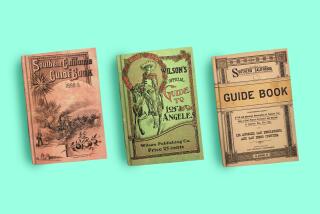Who, What and Wear
- Share via
CHAMPAIGN, Ill. — If all you need from a travel guide is advice on hotels and restaurants, Fielding and Fodor are fine.
But what about down-to-earth advice when the travel bug bites?
What about “the use of baths deters the accumulation of lice, as does the frequent changing of underwear”?
For that sort of information, one must turn to the original--”Peregrinatio in Terram Sanctam” (“Journey to the Holy Land”). Published in 1486, exactly 500 years ago, it was the first illustrated travel book ever printed.
“Peregrinatio” was an instant best seller, going through eight editions. Four months after publication, it was translated from Latin into German. Two years later, French and Dutch versions came out; another decade later, a Spanish translation.
Europeans, not yet aware of the existence of the New World, were absorbed by German nobleman Bernhard von Breydenbach’s pilgrimage through an exotic land with strange customs and laws.
And those inspired to duplicate the journey gleaned advice on how to deal with the six-legged terrorists that preyed on 15th-Century travelers:
--A preemptive strike can dispel mosquitoes with “water in which black hellebore has been boiled and by the smoke of the poison citron tree.”
--Retaliatory raids on fleas are done with “smoke of the chaff of grain or cow dung.”
It probably sounded better in Latin.
Today, with only a few copies known to exist in the United States, the book sounded like an ideal addition to the collection of incunabula--books published in the first half-century of printing--at the University of Illinois. The Urbana-Champaign campus has the largest library of any American public university and the largest research collection west of the Potomac, trailing only the Library of Congress, Harvard and Yale.
After waiting 64 years for one to come on the American market, Illinois this month acquired a perfectly preserved first edition of “Peregrinatio” as its 7 millionth volume. The book was a gift from alumnus John E. (Bud) Velde Jr., president of Paisano Productions, which owns the rights to the works of Erle Stanley Gardner and “The Perry Mason Show.”
Von Breydenbach, dean of the cathedral at Mainz, Germany, took a retinue of 150 on his pilgrimage, including wood-block artist Erhardus Reuwich. As a result, the book was the first with illustrations specifically designed to go with the text--and the first to have those illustrations on fold-out panels.
A panoramic view of Venice stretches out more than 5 feet, with such detail and realism that the view is instantly recognizable to the modern tourist standing at the church of St. Giorgio Maggiore.
Six other illustrations of cities and ports include the first published portrayal of Palestine and lifelike depictions of such places as Crete and Rhodes. William Morris, the 19th-Century English artist and book designer, called the woodcuts the best-executed in any medieval book.
The cities and ports are joined by a half-dozen woodcuts of the people and costumes of the region and of strange animals encountered in the Holy Land--including a unicorn.
If the book’s accuracy on that score seems a bit shaky, there is no denying its expertise on smaller creatures. Can anyone be prepared to dispute its prescription for killing lice? “Dip underwear in mercury mixed with oil.”
More to Read
Sign up for The Wild
We’ll help you find the best places to hike, bike and run, as well as the perfect silent spots for meditation and yoga.
You may occasionally receive promotional content from the Los Angeles Times.






